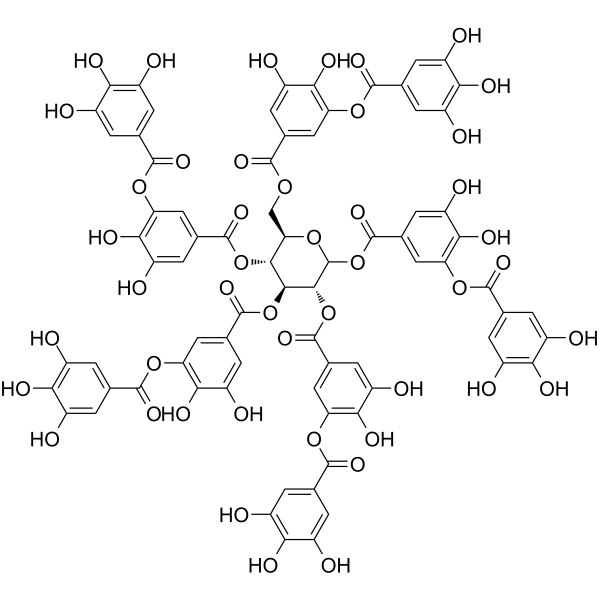上海金畔生物科技有限公司为生命科学和医药研发人员提供生物活性分子抑制剂、激动剂、特异性抑制剂、化合物库、重组蛋白,专注于信号通路和疾病研究领域。
Tannic acid (Synonyms: 单宁酸)
Tannic acid 是一种新型的 hERG 通道阻塞剂,其IC50 值为 3.4 μM。

Tannic acid Chemical Structure
CAS No. : 1401-55-4
| 规格 | 价格 | 是否有货 | 数量 |
|---|---|---|---|
| 10 mM * 1 mL in DMSO | ¥500 | In-stock | |
| 500 mg | ¥400 | In-stock | |
| 1 g | ¥500 | In-stock | |
| 5 g | ¥700 | In-stock | |
| 10 g | 询价 | ||
| 50 g | 询价 |
* Please select Quantity before adding items.
Tannic acid 相关产品
•相关化合物库:
- Natural Product Library Plus
- Drug Repurposing Compound Library Plus
- FDA-Approved Drug Library Plus
- FDA-Approved Drug Library Mini
- Bioactive Compound Library Plus
- Immunology/Inflammation Compound Library
- Membrane Transporter/Ion Channel Compound Library
- Natural Product Library
- FDA-Approved Drug Library
- Anti-Cancer Compound Library
- Drug Repurposing Compound Library
- NMPA-Approved Drug Library
- Phenols Library
- Pyroptosis Compound Library
- Traditional Chinese Medicine Monomer Library
- FDA Approved & Pharmacopeial Drug Library
- Anti-Alzheimer’s Disease Compound Library
- Neurodegenerative Disease-related Compound Library
- Food Additive Library
- Food-Sourced Compound Library
| 生物活性 |
Tannic acid is a novel hERG channel blocker with IC50 of 3.4 μM. |
IC50 & Target |
IC50: 3.4 μM (hERG channel)[1] |
||||||||||||||
|---|---|---|---|---|---|---|---|---|---|---|---|---|---|---|---|---|---|
| 体内研究 (In Vivo) |
During the course of treatment, tannic acid significantly ameliorates these phenotypes in AD skin lesions. Tannic acid treatment aslo reduces these dermal changes compare with AD mice. Treatment with tannic acid increases PPARγ expression in AD skin sections. The PPARγ protein expression is suppressed in vehicle-treated AD mice, but when treats with tannic acid, its expression is increased dramatically. The IL-1β, TNFα, TNFR1, and COX2 protein expressions are significantly up-regulated in vehicle-treated AD mice, but significantly suppressed by tannic acid treatment[2]. 上海金畔生物科技有限公司 has not independently confirmed the accuracy of these methods. They are for reference only. |
||||||||||||||||
| Clinical Trial |
|
||||||||||||||||
| 分子量 |
1701.20 |
||||||||||||||||
| Formula |
C76H52O46 |
||||||||||||||||
| CAS 号 |
1401-55-4 |
||||||||||||||||
| 中文名称 |
鞣酸;单宁酸;丹宁酸;没食子鞣酸 |
||||||||||||||||
| 运输条件 |
Room temperature in continental US; may vary elsewhere. |
||||||||||||||||
| 储存方式 |
|
||||||||||||||||
| 溶解性数据 |
In Vitro:
H2O : ≥ 100 mg/mL (58.78 mM) DMSO : 100 mg/mL (58.78 mM; Need ultrasonic) * “≥” means soluble, but saturation unknown. 配制储备液
*
请根据产品在不同溶剂中的溶解度选择合适的溶剂配制储备液;一旦配成溶液,请分装保存,避免反复冻融造成的产品失效。 In Vivo:
请根据您的实验动物和给药方式选择适当的溶解方案。以下溶解方案都请先按照 In Vitro 方式配制澄清的储备液,再依次添加助溶剂: ——为保证实验结果的可靠性,澄清的储备液可以根据储存条件,适当保存;体内实验的工作液,建议您现用现配,当天使用; 以下溶剂前显示的百
|
||||||||||||||||
| 参考文献 |
|
| Animal Administration [2] |
Specific pathogen-free female 6 weeks old mice are used. The animals are maintained in a controlled room (temperature 23±2 °C, humidity 55±15%, 12 h light cycle). After 1 week, the mice arer andomly divided into 3 groups, untreated group-receive vehicle (distill water) (Normal, n=5); DfE cream treated mice (100 mg/mouse) is divided into two groups and each receives vehicle (distill water) (AD, n=5) or Tannic acid (80 mg/kg/day, per oral) (AD+Tannic acid, n=5) and are allowed free access to drinking water and standard laboratory diet[2]. 上海金畔生物科技有限公司 has not independently confirmed the accuracy of these methods. They are for reference only. |
|---|---|
| 参考文献 |
|
所有产品仅用作科学研究或药证申报,我们不为任何个人用途提供产品和服务
